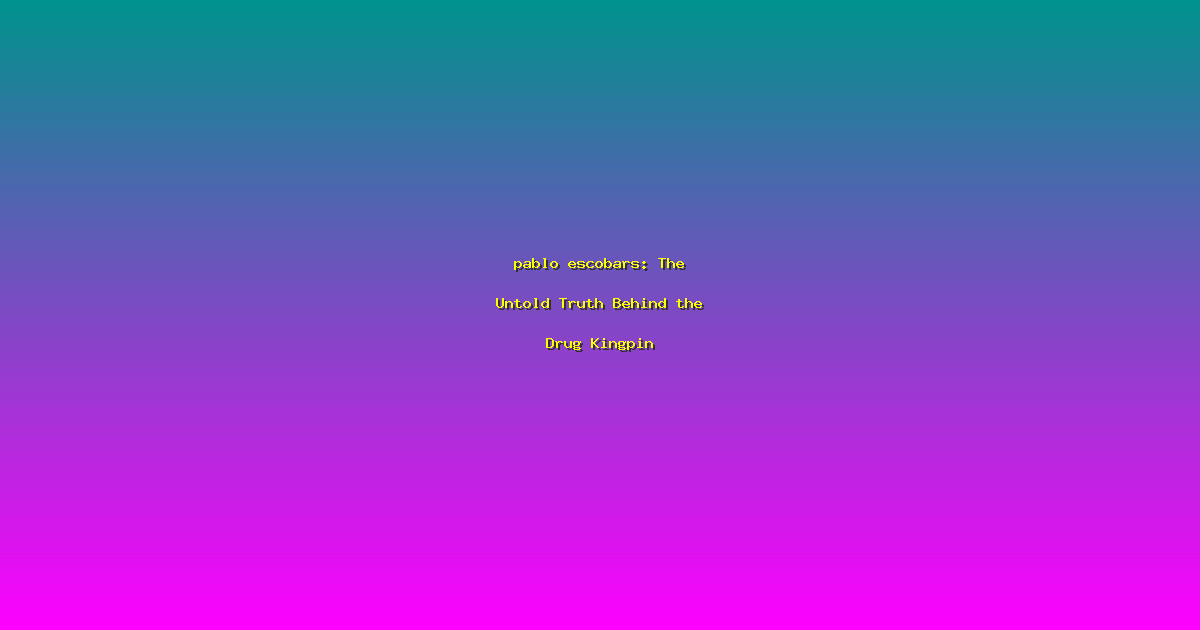pablo escobars: The Untold Truth Behind the Drug Kingpin
When we think of drug kingpins, one name often comes to mind: Pablo Escobar. But what if there were more like him, operating in the shadows? This article delves into the untold stories of pablo escobars, revealing the complex web of power, corruption, and violence that they wielded. By understanding their methods and motivations, we can better grasp the impact they had on the drug trade and the world at large. Join us as we uncover the hidden truths behind these notorious figures.
The Rise of Pablo Escobars
The rise of pablo escobars is a tale of ambition, ruthlessness, and cunning. These individuals, often operating in the shadows, built empires that spanned continents. Their rise to power was not just about drugs; it was about control, influence, and money. One of the most notorious examples is Pablo Escobar himself, who rose from humble beginnings to become one of the wealthiest and most feared men in the world.
- Key point: The Medellin Cartel, led by Pablo Escobar, was responsible for smuggling over 15 tons of cocaine into the United States each day at the height of its power.
- Key point: Escobar’s influence extended beyond drug trafficking; he used his wealth to buy political favors and silence his enemies, creating a network of corruption that was nearly impossible to dismantle.
- Key point: According to historian Steven Dudley, “Escobar’s methods were brutal and effective, but they also set a dangerous precedent for future drug lords.”
The Impact on Society
The impact of pablo escobars on society cannot be overstated. Their actions have left a lasting legacy of violence, corruption, and social upheaval. The drug trade they controlled has fueled countless crimes and contributed to the destabilization of entire regions. For example, the violence in Colombia during the 1980s and 1990s was largely a result of the power struggles between different drug cartels.
- Key point: The Medellin Cartel’s war against the Colombian government resulted in over 3,000 deaths in 1989 alone.
- Key point: The United Nations estimates that the global drug trade generates over $300 billion annually, much of which is controlled by organizations similar to those led by pablo escobars.
- Key point: To combat the influence of these drug lords, law enforcement agencies have had to develop sophisticated strategies, including the use of informants and international cooperation.
The Aftermath and Legacy
The aftermath of the reign of pablo escobars has left a complex legacy. While their empires have fallen, the systems they created continue to influence the drug trade today. The violence and corruption they fostered have left deep scars on the societies they affected. However, their downfall also serves as a cautionary tale about the dangers of unchecked power and the importance of strong legal and ethical frameworks.
- Key point: After Escobar’s death in 1993, the Medellin Cartel fragmented, leading to a power vacuum that was filled by other criminal organizations.
- Key point: According to criminologist Dr. Maria Rodriguez, “The legacy of pablo escobars is a reminder of the need for international cooperation and robust law enforcement to combat organized crime.”
- Key point: Today, efforts to combat drug trafficking include not only law enforcement but also social programs aimed at reducing demand and providing alternatives to those involved in the drug trade.
Frequently Asked Questions
How did Pablo Escobar rise to power?
Pablo Escobar rose to power through a combination of ruthless tactics, strategic alliances, and a willingness to use violence to eliminate his rivals. He started small, smuggling drugs across the border, and gradually expanded his operations, eventually controlling a vast network of suppliers, distributors, and corrupt officials.
What was the impact of the Medellin Cartel on Colombia?
The Medellin Cartel, led by Pablo Escobar, had a profound impact on Colombia. The violence and corruption they fostered destabilized the country, leading to a period of intense conflict and social upheaval. The cartel’s war against the government resulted in thousands of deaths and left a lasting legacy of violence and fear.
How did law enforcement eventually bring down Pablo Escobar?
The downfall of Pablo Escobar was the result of a combination of factors, including the use of informants, international cooperation, and a relentless pursuit by law enforcement agencies. The Colombian government, with the help of the United States, launched a series of operations that ultimately led to Escobar’s capture and death.
What is the current state of the drug trade in Colombia?
While the power of the Medellin Cartel has waned, the drug trade in Colombia continues to be a significant issue. Today, smaller, more decentralized organizations control much of the drug trafficking, making it more difficult to combat. However, there have been significant improvements in law enforcement and international cooperation, leading to a reduction in violence and increased efforts to address the root causes of drug trafficking.
What lessons can be learned from the reign of Pablo Escobar?
The reign of Pablo Escobar serves as a stark reminder of the dangers of unchecked power and the importance of strong legal and ethical frameworks. It highlights the need for international cooperation, robust law enforcement, and social programs aimed at reducing demand and providing alternatives to those involved in the drug trade.
Conclusion
The story of pablo escobars is one of ambition, violence, and corruption. Their rise to power and the subsequent efforts to bring them down have left an indelible mark on the world. By understanding their methods and motivations, we can better address the ongoing challenges of drug trafficking and organized crime. The legacy of pablo escobars serves as a cautionary tale, reminding us of the importance of strong legal and ethical frameworks and the need for continued vigilance in the fight against organized crime.
